As rising seas invade Waikiki resorts, state proposes adding more groins
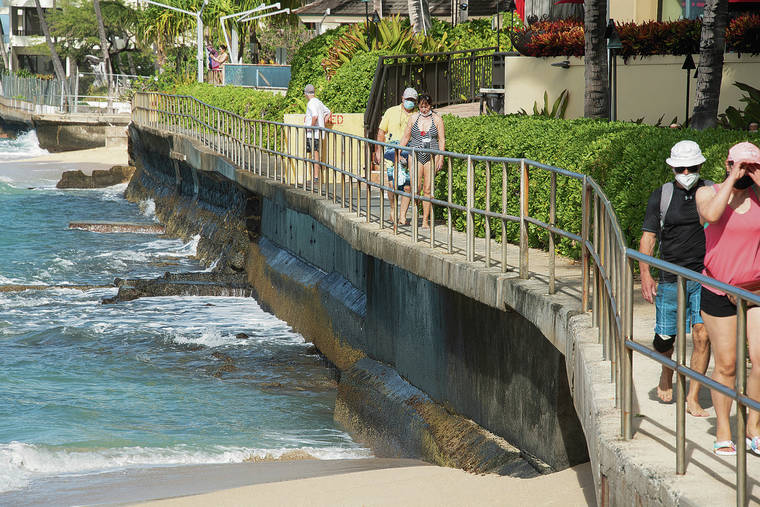
CRAIG T. KOJIMA/CKOJIMA@STARADVERTISER.COM
Beachgoers walk on a section of seawall above the reef where green sea turtles feed.
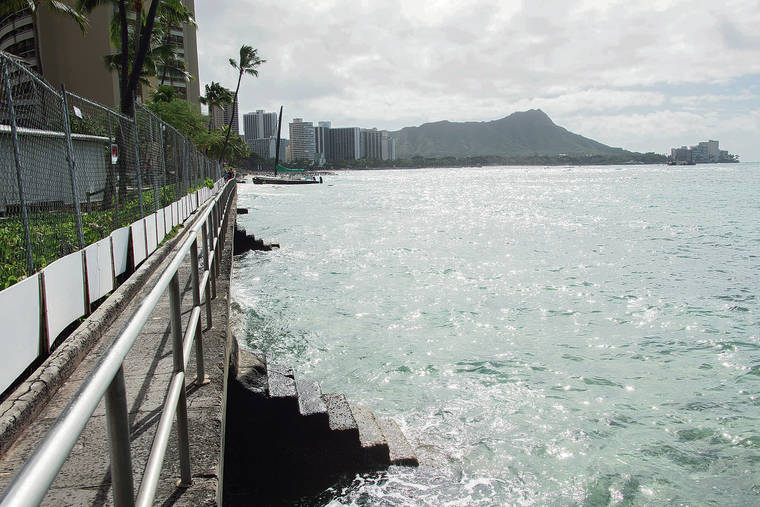
CRAIG T. KOJIMA/CKOJIMA@STARADVERTISER.COM
A walkway runs atop the oceanfront seawall past the Halekulani and Sheraton Waikiki resorts.
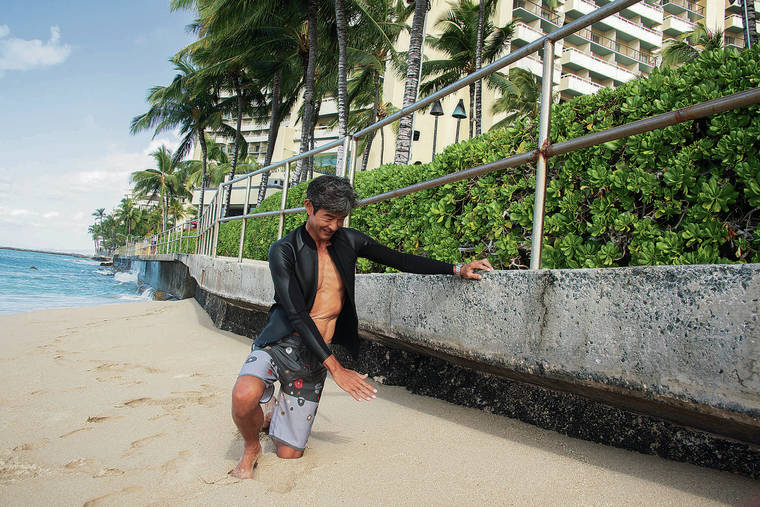
CRAIG T. KOJIMA/CKOJIMA@STARADVERTISER.COM
Waikiki resident Dennis Furukawa shows how much sand levels in front of a Waikiki seawall can vary with tides, currents and seasonal changes.
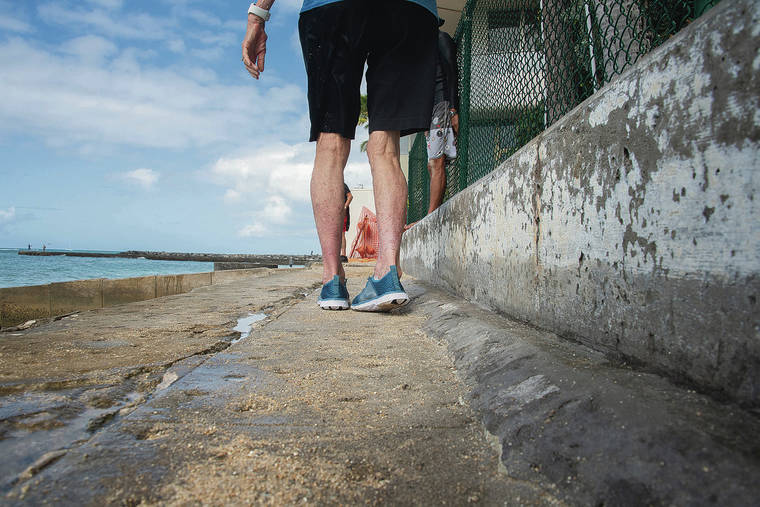
CRAIG T. KOJIMA/CKOJIMA@STARADVERTISER.COM
An older woman continues along the seawall walkway in front of the Halekulani after tripping and falling on the uneven surface.
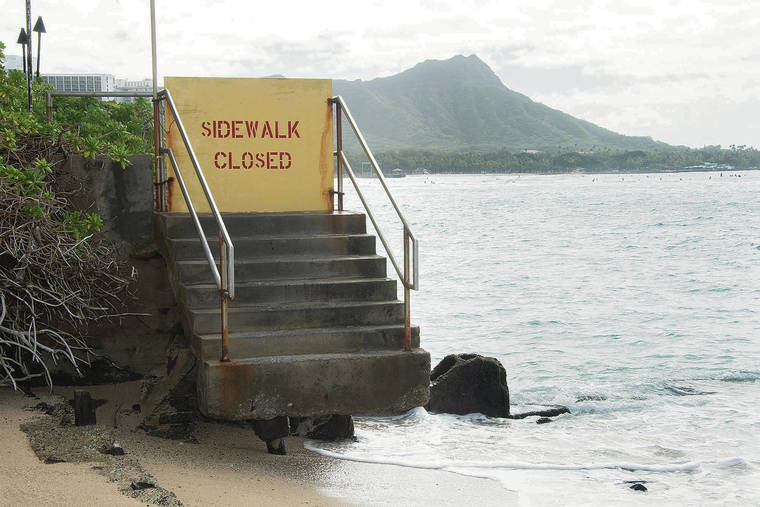
CRAIG T. KOJIMA/CKOJIMA@STARADVERTISER.COM
Public access is barred where a portion of seawall is closed.
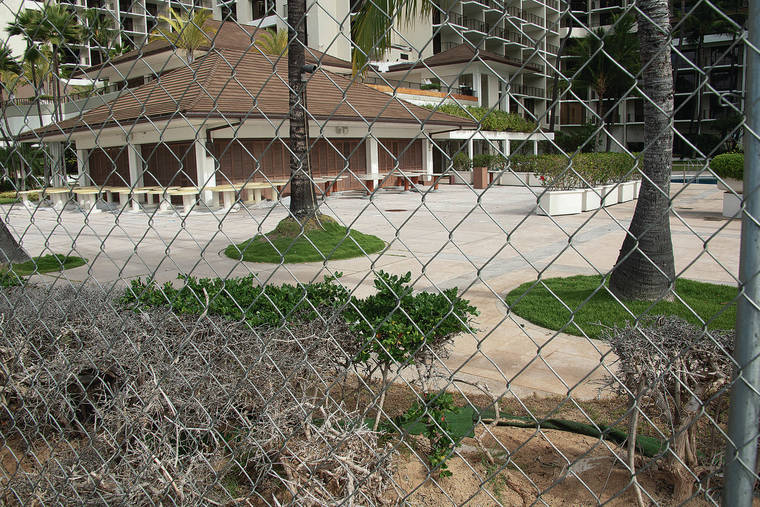
CRAIG T. KOJIMA/CKOJIMA@STARADVERTISER.COM
Halekulani landscaping is being killed by encroaching salt water as sea levels rise with climate change.
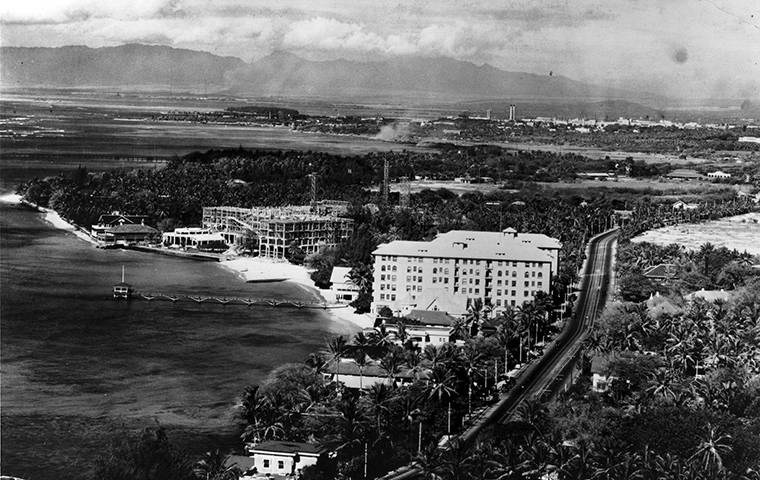
PHOTO BY 11TH PHOTO SEC., AIR SERVICE, U.S. ARMY, COURTESY SAVE OUR SURF
Looking back
Waikiki beach, 1925
Seawalls cause beach erosion, as visible in front of the Royal Hawaiian Hotel under construction. After the Royal Hawaiian groin was built in 1927, sand accumulated in front of the Royal but disappeared from other areas of the beach Ewa of the Royal Hawaiian Hotel.







Waikiki, its shoreline eroded by seawalls and battered by rising seas, sits on the brink of more upheaval that could either destroy its few surviving natural features or protect its disappearing beach for decades, depending on one’s viewpoint.
A draft environmental impact statement is being prepared for a $12 million Waikiki Beach Improvement and Maintenance Program, proposed by the state Department of Land and Natural Resources in partnership with the Waikiki Beach Special Improvement District Association, that envisions constructing structures makai of the waterline, dredging sand and placing it on the shore; the entire program area extends from the Kapahulu Groin to the Ewa end of Fort DeRussy Beach.
One hotly debated section of the plan is to build three 200-foot-long T-head groins and a 3.8-acre beach out from the seawall fronting the Sheraton Waikiki and Halekulani resorts to help protect against coastal erosion and sea level rise and preserve tourism revenues, which would shrink by $2.2 billion a year if Waikiki Beach were to disappear, according to the state’s environmental impact statement public notice.
Critics of the proposal expressed concerns that nearshore reef habitat for the endangered Hawaiian green sea turtle would be covered by the rock-rubble groins and the sand; that the groins would alter surf breaks and endanger swimmers; and that the plan does not protect the public’s right under the Hawaii Constitution to access and laterally traverse the shoreline.
Eroding access
For nearly a century the public has traversed the storied Halekulani waterfront on a sidewalk atop the seawall, but now a 75-foot-long section of the path has been closed for more than three years.
Don't miss out on what's happening!
Stay in touch with breaking news, as it happens, conveniently in your email inbox. It's FREE!
Portions of the wall, which stands an average 5-1/2 feet high, have eroded and are awash with sand and seawater; on a recent morning, passersby rushed to assist a senior pedestrian when she tripped and fell.
Waikiki resident Dennis Furukawa, an architect, said the walkway needs to be repaired and made compliant with the Americans With Disabilities Act.
“The first step should be to deal with the seawall — they missed the whole point about public access,” Furukawa said, noting that while the EIS public notice said providing safe access to and along the shoreline is a primary objective, it also mentioned constructing a new, ADA-compliant beach walkway as one option.
In his comments, Furukawa recommended forgoing the groins and beach and instead rebuilding the existing seawall to be ADA-compliant.
The seawall also needed reinforcing because “Gray’s Beach (in front of the Sheraton and Halekulani) is moving up and mauka,” he said, pointing out how the sand was leaping over the wall as waves pushed the beach inland.
Mauka of the wall, the grounds of the luxury resorts were marred by salt-withered vegetation and sand that had breached piles of sandbags and other improvised barriers; a dead tree lay in front of the Halekulani, closed due to the coronavirus pandemic; and past the Ewa end of the wall, shorebreak struck the walls of the Outrigger Reef Hotel.
“This is a case study for managed retreat,” Furukawa said, “or they’ll have to rebuild the seawall.”
This erosion, caused by backwash off the seawall, was precisely what the proposed groins and beach nourishment would mitigate, said Sam Lemmo, administrator of DLNR’s Office of Conservation and Coastal Lands, because the new beach would “push all the (wave) energy out into the ocean so it doesn’t end up transferred onto the properties,” and the groins would stabilize the new beach, preventing it from eroding so quickly that it would need frequent nourishing — although periodic nourishing would still be needed.
Sand trap
Keone Downing, who submitted comments on behalf of Save Our Surf, criticized the public expense and negative impacts of T-groins.
He cited the book “Against the Tide: The Battle for America’s Beaches,” by Cornelia Dean, a former science editor of The New York Times, which documents serial erosion caused by shoreline armoring on America’s coastlines.
“Usually, groins cause more problems than they cure,” Dean writes. “They aren’t much to look at and they make long walks along an unobstructed beach a thing of the past. On beaches with any kind of surf, they pose a potentially serious hazard to swimmers. And they leave property owners downdrift bereft of sand.”
Downing said Save Our Surf wasn’t against adding sand to shorelines, but opposed building a big new beach at taxpayer expense where “before the Royal Hawaiian Groin was built, there was a seasonal beach; even today the sand comes back in winter, but it’s small and mostly at low tide.”
On the Diamond Head side of the groin, Royal Hawaiian Beach received 24,000 cubic yards of dredged offshore sand in 2012, and another 20,000 cubic yards is being added now in a partnership between the Office of Conservation and Coastal Lands and the Waikiki Beach Special Improvement District Association.
Last year the association split the $1.85 million cost of restoring the Royal Hawaiian Groin with the state, and it is contributing $1 million of the $4 million for the current beach nourishment.
For the proposed program, the Waikiki Beach Special Improvement District Association would pay $3 million of the estimated $12 million cost; its funding for Waikiki projects comes from a special tax assessed on its membership of hotels and other property owners in the district.
In a 2003 article, “Waikiki: Historical Analysis of an Engineered Shoreline,” Tara L. Miller and Charles H. Fletcher write that the Royal Hawaiian Groin, built in 1927, “was reported to be successful in maintaining sand (on the Royal Hawaiian beach),” but “downdrift starvation was caused to Halekulani Beach to the west.”
Lemmo said that wouldn’t result from the new project.
“If you put a groin on open beach, yes, it would cause downdrift,” he said, “but in this case there would be no downdrift or updrift impacts because the entire (project) area is bounded by the Royal Hawaiian and Fort DeRussy groins.”
Charles “Chip” Fletcher, a professor in the Department of Earth Sciences of the School of Ocean and Earth Science and Technology, University of Hawaii at Manoa, and a leading researcher on sea level rise who co-authored the 2003 article, said he supported adding T-groins.
“Without the groins there would have to be new sand put at Gray’s Beach in a couple of years,” said Fletcher, whose graduate students’ Waikiki research is partially funded by the Waikiki Beach Special Improvement District Association. “The groins will allow that sand to be stable for a longer period of time.”
But ultimately, waterfront structures will “have to get out of the way and let the beach migrate, or keep putting sand, but that’s going to get harder and finally impossible,” he said.
“I think there’s a serious question if we’ll have a Waikiki Beach in the second half of this century, when the ocean will be at least a foot, maybe 2 feet higher,” Fletcher said, noting that Waikiki is also a barrier beach backed by wetlands, and the rising water table due to climate change “will hit it in the back.”
Downing said the public didn’t need a big new beach at the Halekulani and Sheraton in light of the big, freshly nourished Royal Hawaiian Beach next door.
“They’re making a beach for the hotels, so why should the public be paying?” he asked. “We’ve made it with the beaches we have to over 10 million visitors,” he added, referring to Hawaii’s total visitors in 2019.
Doorae Shin, administrator of Surfrider’s Oahu chapter, also questioned the expenditure of public money on the shoreline fronting hotels in areas with limited public access, and asked that the EIS examine the potential for adding public access routes between the Halekulani and Sheraton hotels, and affordable public parking in close proximity to the beach.
Advocating a comprehensive approach to shoreline erosion, Shin also asked that the EIS include a framework to help the government allocate limited resources between Waikiki and other priority coastal areas in critical need of maintenance and restoration.
Living waters
Some argue that because Waikiki’s shoreline has been engineered over more than a century, there is little surviving nature to be harmed by building walls and groins and dredging and placing sand.
Companion bills introduced in the state House of Representatives and Senate this session sought to amend a state law for coastal zone management, Section 205A-2, Hawaii Revised Statutes, by exempting Waikiki from its prohibition against constructing private erosion-protection structures seaward of the shoreline.
Both bills failed to advance; SB 796 might be taken up again next session, according to the office of state Sen. Lorraine Inouye, chairwoman of the Water and Land Committee.
“Given the threats posed by sea level rise and erosion, it didn’t seem advisable to give a blanket exemption to our coastal zone management laws for the Waikiki area,” state Sen. Mike Gabbard, chairman of the Agriculture and Environment Committee, said in an email.
Furukawa, the Waikiki resident, said nature still thrived in the Halekulani beach cell, pointing out bluegreen needlefish flickering through the clear waters off the seawall. “There are so many reef fish, honu, sharks and rays in this area,” he said. “You don’t see much sea life in front of the Royal Hawaiian or the Moana Surfrider, where the water is crowded with people and the reef is covered by sand.”
The Halekulani shoreline, known as Kawehewehe, was a traditional healing and gathering place, drawing bathers to its ocean waters, where fresh spring water still flows forth; studies show such riparian areas provide rich feeding grounds and nurseries for fish.
Shin asked that the EIS include short- and long-term impacts to water quality, beach sand quality, reef health, surf breaks and near-shore ocean currents.
Dolan Eversole, a coastal-processes specialist at University of Hawaii’s Sea Grant College and Waikiki Beach management coordinator for the Waikiki Beach Special Improvement District Association, which pays the university for his services, agreed the area was special.
“There is coral and algae that is alive,” he said. “If we put T-head groins on top of them, the National Oceanographic and Atmospheric Administration will probably require we do some sort of mitigation, maybe reef conservation by the (Waikiki) aquarium where there is live reef.”
Regarding concerns that backwash off the T-groins could alter the waves of the Populars, Paradise and Number Threes surf breaks, Eversole said EIS consultant Sea Engineering could do some wave modeling, but that in his years of surfing the area, he hadn’t observed refraction off the existing seawall affecting the surf breaks 800 feet offshore.
In a 2008 proposal for a proposal to build three T-head groins at the Halekulani/Sheraton seawall, Sea Engineering said the groins would reduce wave refraction off the seawall out to Populars by an estimated 80%.
Shoreline rights
In all, 26 letters of testimony expressing criticism/complaints, observations/suggestions and support for the EIS public notice were received by the Jan. 22 deadline, Eversole said; this testimony will not be made public until the release of a draft EIS, when public hearings will be held and more testimony accepted.
Writing in support of the program, Douglas Meller also recommended the EIS propose the state use eminent domain to acquire all private littoral rights between the Royal Hawaiian Hotel groin and Fort DeRussy, noting ownership had been granted to shoreline property owners, along with permission to build seawalls, by the Territory of Hawaii in 1928.
Meller also suggested the state acquire the beach “makai of the existing ‘Line A’ under the 1965 (Moana) Surfrider-Royal Hawaiian Sector Beach Agreement,” referring to the beach corridor where a public easement was established and commercial activities, such as setting out chairs and umbrellas, were prohibited.
In 2008, when Save Our Surf opposed Sheraton Waikiki owner Kyo-ya’s proposal for T-head groins in the Halekulani sector, George Downing, the late big-wave pioneer and Keone Downing’s father, warned of “continued attempts over the years to push the shoreline of Waikiki into our surf areas by the tourist industry to get wider beaches for their guests.”
He recommended the surf breaks of Waikiki’s Mamala Bay be preserved as an “Ocean Park” along the lines of Hanauma Bay.
The EIS public notice can be viewed at dlnr.hawaii.gov/occl/files/2021/01/2020-12-23-OA-EISPN-Waikiki-Beach-Improvement-and-Maintenance-Program.pdf Opens in a new tab.




